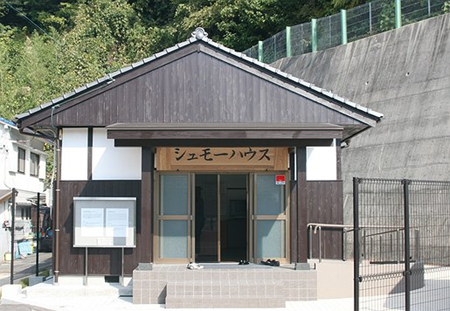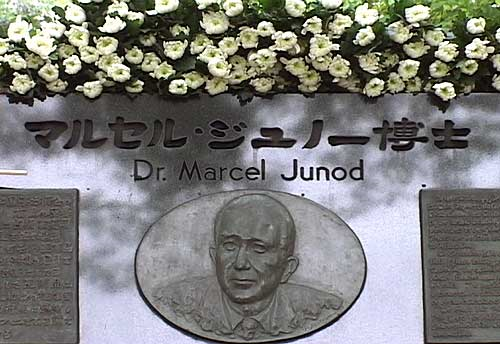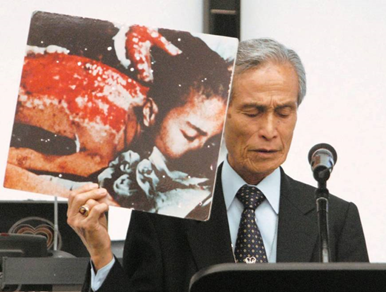Remarkable People
After the war, despite GHQ’s ban on the dissemination of information about Hiroshima and Nagasaki, people outside Japan gradually became aware of the human sufferings in both cities. The aid came initially from the Japanese communities in the US. As all the letters from Japan were subject to censorship, the Japanese descendants learned the situation only from those who visited Japan. It was not until 1946, one year after the war, when John Hersey’s “Hiroshima” was published in the US and then internationally, that the consequences of the bombing of Hiroshima on the people became widely known outside Japan. The publicity resulted in more aid to Hiroshima. In the first few years after the war, the survivors were left with practically no aid from overseas or the Japanese Government, which was financially and politically incapable of helping the survivors at that time.
Every story has two sides; so does the case of Hiroshima. While some people, in the name of a war, knowingly engaged in indiscriminate killings of hundreds of thousands of people by atomic bombs, there were also individuals who have rendered kind support to the survivors and/or devoted themselves for the cause against nuclear weapons. Among those individuals, I have selected those listed below who I regard as the most remarkable people and for whom I have profound respect.
Dr Floyd Schmoe (Houses for Hiroshima project)
Dr Floyd Schmoe was a Quaker and a peace activist throughout his life, helping various people in different countries, where humanitarian help was needed. He opposed the internment of Japanese Americans during the war and left his university teaching position to go to the internment camps to help the Japanese. After the war, he travelled to Hiroshima and Nagasaki with funds he raised, to build houses for atomic bomb survivors. Spending five years in Hiroshima from 1949 and 1953, he built 21 houses and assembly facilities called “Houses for Hiroshima” with both American and Japanese volunteers. He also devoted himself to building the Seattle Peace Park which he funded using the prize money from the Hiroshima Peace Prize awarded to him in 1988. A statue of Sadako Sasaki holding origami paper cranes was erected in the park. Dr Schmoe received Japan’s highest civilian award, the Order of the Rising Sun, Gold and Silver Star.
“[He] was nominated for the Nobel Peace Prize three times by U.S. Rep. Jim McDermott (D-Wash.). In his nomination letter, the congressman acknowledged that Schmoe was not as well-known as other nominees, such as former President Jimmy Carter. But the man who had spent his lifetime “doing small things for peace” possessed a personal moral authority every bit as compelling as that of the most renowned leaders of our time. (Los Angeles Times)”
The only house that still stands today was turned into a branch of the Hiroshima Peace Memorial Museum in 2012. The opening ceremony of the branch was attended by the Schmoe family and a group of Seattle volunteers who travelled to Hiroshima to build houses with Dr Schmoe.
Sources and further information:
- “Floyd Schmoe; Activist for Peace for Nearly a Century”, Los Angels Times, 29 April 2001.
http://articles.latimes.com/2001/apr/29/local/me-57286 - “Hiroshima fetes peace activist”, Japan Times, 1 November 2012.
https://www.japantimes.co.jp/news/2012/11/01/national/hiroshima-fetes-peace-activist/#.WaqSS_Pygzw - “Floyd Schmoe—101 Years of Peace and Action”, Seattle Times, 14 September 1997.
http://community.seattletimes.nwsource.com/archive/?date=19970914&slug=2560194 - “Floyd Schmoe”, Quakers in the World.
http://www.quakersintheworld.org/quakers-in-action/245/Floyd-Schmoe - “The Schmoe House, Houses for Hiroshima Project, Grand Opening Ceremony – Hiroshima, Japan”, Discover Nikkei,
http://www.discovernikkei.org/en/nikkeialbum/albums/533/?view=list

Dr Marcel Junod (Humanitarian action)
When Dr Marcel Junod arrived in Japan on 9 August 1945 as Chief Representative of the International Red Cross Committee to Japan, his initial task was to visit the prisoners of the Allied Forces. However, as the war ended shortly after his arrival, and as he learned about the tragedies of Hiroshima and Nagasaki, he became involved in helping those who were suffering. He arrived in Hiroshima on September 8th with 12 tons of medical supplies, and became the first non-Japanese doctor to treat survivors of the atomic bombing. Without him, such a delivery of desperately needed medical supplies would not have been realized. Hiroshima Red Cross Hospital became a center for the treatment of atomic bomb survivors, and it is still called the Atomic Bomb Hospital in Japanese.
In 1979, a monument was erected in the Peace Park in Hiroshima to honor Dr Junod for his humanitarian assistance given to the survivors. The inscription engraved on the back of the monument, “Innumerable cries are asking for your help,” is a quotation from one of his writings. In the same year, he was posthumously awarded the Order of the Sacred Treasure by the Japanese government. Each year on the anniversary of his death of June 16th, a commemorative meeting is held in front of the monument in the Peace Park. On 13 September 2005, 60 years after he left Hiroshima, a similar monument was inaugurated in Geneva by the town and cantonal authorities.
His witness account of Hiroshima appears on the website of the International Committee of the Red Cross at https://www.icrc.org/eng/resources/documents/misc/hiroshima-junod-120905.htm
“…At twelve o’clock, we flew over Hiroshima. We… witnessed a site totally unlike anything we had ever seen before. The centre of the city was a sort of white patch, flattened and smooth like the palm of a hand. Nothing remained. The slightest trace of houses seemed to have disappeared. The white patch was about two kilometres in diameter. Around its edge was a red belt, marking the area where houses had burned, extending quite a long way further, difficult to judge from the airplane, covering almost all the rest of the city. It was an awesome sight… “
Sources and further information:
- “Monument in Memory of Dr Marcel Junod”, Hiroshima City.
http://www.pcf.city.hiroshima.jp/virtual/VirtualMuseum_e/tour_e/ireihi/tour_29_e.html - Junod.ch. http://www.junod.ch/en/marcel_junod_eng.shtml

Mr Norman Cousins (Moral adoption project)
Mr Norman Cousins was a journalist, professor of medical humanities and world peace advocate. With his warmth, compassion and sense of humor, and through a numerous number of writings and speeches together with action he undertook, he impacted many people.
He visited Hiroshima in August 1949 as the Editor-in-Chief of the Saturday Review of Literature, a US magazine, and wrote a report entitled “Hiroshima–Four Years Later.” In the report, he introduced the idea of “moral adoption,” a system that could help nurture atomic bomb and war orphans without recourse to legal adoption. Through this system, some 500 children in Hiroshima received assistance of a total amount of 20 million yen from Americans of goodwill.
Moreover, in 1955, Mr Cousins took 25 young female atomic bomb survivors to the U.S. to have their keloids treated at Mount Sinai Hospital in New York. They were nicknamed “Hiroshima Maidens”, and received over 125 operations for 18-month reconstruction surgeries (such advanced plastic surgery was not available in Japan at that time). Local Quakers supported this initiative by Mr Cousins.
He was awarded the title Honorary Citizen of Hiroshima in 1964. He was also a recipient of the Albert Schweitzer Prize for Humanitarianism, the Japan Niwano Peace Prize and others.
Although his involvement in Hiroshima was a small part of his numerous achievements and contributions, it influenced his core belief (see below).

Sources and further information:
- “Monument to Mr Norman Cousins”, Hiroshima City.
http://www.pcf.city.hiroshima.jp/virtual/VirtualMuseum_e/tour_e/ireihi/tour_53_e.html - “Intimate Friends, Relatives Remember Norman Cousins”, Los Angels Times, 28 March 1991.
http://articles.latimes.com/1991-03-28/news/vw-1176_1_norman-cousins - “Hiroshima–Four Years Later”, The Saturday Review, Norman Cousins.
http://www.unz.org/Pub/SaturdayRev-1949sep17-00008 - “Memoirs of an Atomic Bomb Survivor: Shigeko Sasamori”, UCLA Asia Pacific Center.
http://www.international.ucla.edu/asia/article/20488 - “B. E. Simon, ‘Hiroshima Maidens’ Surgeon, 87”, New York Times, 5 August 1999.
http://www.nytimes.com/1999/08/05/nyregion/b-e-simon-hiroshima-maidens-surgeon-87.html?mcubz=3 - “The Dropping of the Atomic Bomb”, Norman Cousins Interview, UC Berkeley, 12 September 1984.
http://globetrotter.berkeley.edu/conversations/Cousins/cousins1.html - “Hiroshima Maidens—Hibakusha Stories”, Norman Cousins,
http://hibakushastories.org/wp-content/uploads/2013/10/Hiroshima-Maidens.pdf - “How did children who were orphaned by the atomic bombing survive afterwards?”, Hiroshima City.
http://www.city.hiroshima.lg.jp/shimin/heiwa/q5e.html - “The ‘Moral Adoption’ of Hiroshima’s A-bomv Orphans, Part I [Introduction]”, Hiroshima Peace Media.
http://www.hiroshimapeacemedia.jp/?p=23309 - “Cousins, Norman”, Harvard Square Library.
http://www.harvardsquarelibrary.org/biographies/norman-cousins-2/
Mr Sumiteru Taniguchi (Peace activist and survivor of Nagasaki atomic bombing)
As a survivor of Nagasaki atomic bombing, Mr Taniguchi devoted his life to informing people of his experience of the atomic bombing and appealing for the nuclear disarmament. He strongly believed that mankind and nuclear weapons could not co-exist and that there were no clean or dirty nuclear weapons. Even in his late 70’s, he was delivering about 200 speeches a year in Japan and overseas. Unable to breathe properly, he could not speak up. He therefore always kept standing trying to speak clearly. In his hand, his audience often found a well-known picture of his—with a horrible red burnt back (see the picture below).
Miraculously survived from the atomic bombing and experiencing pains that were beyond everyone’s imagination, he had a strong sense of duty to work for his causes. A few months before his death at the age of 88, he expressed a concern that the movement for the nuclear disarmament might diminish when there were no more atomic bomb survivors left. In an interview after 60 years from the atomic bombing, he did not hesitate to say that he would never consider those who made, ordered to make, used, or were delighted to have used the atomic bombs to be humans or forgive them. He was nominated for 2015 Nobel Peace Prize.
The following is an excerpt of his speech delivered in the International Peace and Planet Conference held at Cooper Union University in 2015, when he was 86 years old:
After a while, I raised myself and found my entire left arm had been burnt with a peeled skin hanging from the fingertip like a tattered rag. I reached for my back and felt something slimy and black stuck on my fingers. I had no bleeding from injuries nor did I feel any pain. I wondered around like a sleep walker and managed to reach a nearby factory set up in a hillside tunnel about 200 meters away. Inside I asked a woman to cut off the peeled skin dangling from my arms. She tore a piece of cloth out of what was left of my shirt and put machine oil to it and wiped my arms.
Sometime later, we were told to evacuate somewhere else from the tunnel. I tried with all my strength but I couldn’t even get up, let alone walk. A man carried me on his back to the top of the mountain (hill) and laid me down under a tree. When it got dark, US aircraft flew over and attacked us with machine guns as fires that broke out everywhere in the city were bright enough for them to spot the people. Some stray bullets hit the rock next to me and fell on the grass and I was beside myself with fear.
At night there was drizzling rain. I sucked the water dripping from the leaves and spent the night. When the morning came, I found all who were around me were already dead. Some people came for rescue but they passed me by. Perhaps they believed that I too were dead. As I could not raise my voice to cry for help, I had to spend another night there. And in the morning of the third day I was finally rescued. It was around that time that my wounds started to bleed heavily and with it gradually I started to feel the pain.
In early September, I was taken into Nagasaki University Hospital and in November I was transferred to the Navy Hospital in the suburbs of Nagasaki. By that time all emergency first aid stations were closed but most of hospitals in Nagasaki were still in ruins. With heavy burns all over my back, I could not move nor sit straight nor lie on my back. Helplessly lying on my stomach, in excruciating pain and agony, I was crying “Kill me.” No one believed that I would survive another day. Every morning I would hear doctors and nurses whisper at my bedside saying, “He’s still alive”. I was hovering between life and death but failed to perish and somehow was made to live. I have been in and out of the hospital many times since then. Around 1981, tumors started to develop on the keloid scars on my back and they had to be removed by surgery. Since then, a rock hard tumor was formed again and again and was removed, the cause of which even doctors were unable to explain. It might have been due to the effects of radiation. Miraculously I was able to survive to this day.
But with only two atomic bombs dropped on Hiroshima and Nagasaki on these two days, more than 200,000 people were burnt to ashes almost instantly. More people continue to suffer bitterly and die during the ensuing period from the A-bomb diseases. Nuclear arms are weapons of the devil which will not allow humans to live nor die as humans. The use of nuclear weapons is the worse crime against humanity. With a hibakusha during the past 70 years since that day (who) continued to call on the top of their voices appealing prevent nuclear war and abolish nuclear weapons. No more hibakusha. Don’t repeat Hiroshima and Nagasaki anywhere in the world. (https://www.youtube.com/watch?v=Q2vPTXLBqck)


“During 3 years and 7 months of hospitalization, I kept lying on my stomach for 1 year and 9 months. As I couldn’t move an inch my chest, I suffered severe bedsores even to the bones. My chest now looks as if it has been deeply scooped and even today you can clearly see my heart beating against the skin between the ribs. I have managed to survive to this day overcoming numerous crises and difficulties. Friends, let us make this Peace and Planet Conference mark a firm step toward achieving a total ban on nuclear weapons. We must save our blue planet for future generations. Even a single nuclear weapon should not be allowed to exist. Let us spread our call for the abolition of nuclear weapons all over the world. No more Nagaski. No more hibakusha. No more war.” (https://www.youtube.com/watch?v=Q2vPTXLBqck)
Nagasaki had a population of 240,000 at the time of the atomic bombing. Almost 74,000 people died by the year-end, 65 percent of whom were women, children and the aged. Those exposed to the atomic bombing and survived counted 140,000, which means that the atomic bombing dropped in the heart of the city killed or affected nearly 90 percent of the population. The US planned to drop the atomic bomb on Kokura which together with surrounding cities had a larger population and area, but due to the weather on the bombing day, they dropped it on Nagasaki.
Sources and further information:
- Mr Taniguchi’s speech in the International Peace and Planet Conference in 2015.
https://www.youtube.com/watch?v=Q2vPTXLBqck - “Bound by the bomb: ‘I spurred myself to stay alive’”, Tri-City Herald.
https://web.archive.org/web/20081006144605/http://archive.tri-cityherald.com/BOMB/bomb24.html - “Face of Nagasaki dies of cancer at 88: Postman whose badly burned body became an iconic image of the devastation caused by atomic bomb had passed away”, Dailymail, 30 August 2017.
http://www.dailymail.co.uk/news/article-4835652/Postman-survived-Nagasaki-A-bomb-dies-88.html#ixzz4ttVqoml4
Continued.

